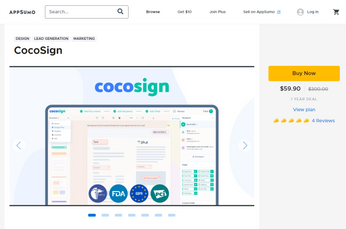
Future Trends in E-Signatures: Artificial Intelligence, Biometrics, and More
As technology continues to evolve, the landscape of electronic signatures (e-signatures) undergoes constant transformation. This article delves into the future trends shaping the realm of e-signatures, focusing on emerging technologies such as Artificial Intelligence (AI), text-to-speech software, AI text-to-video, AI text-to-art, biometrics, blockchain, quantum-safe cryptography, and more.
With an in-depth exploration of these trends, their implications, and potential applications, this article aims to provide a comprehensive understanding of the direction in which e-signature technology is headed.
Introduction
The adoption of electronic signatures has revolutionized the way transactions are conducted in the digital age. As businesses increasingly shift towards paperless processes, the future of e-signatures is poised for exciting advancements. This section sets the stage for a detailed exploration of the emerging trends that will shape the landscape of e-signatures in the years to come.
This article seeks to unravel the future trends in e-signatures, focusing on the integration of Artificial Intelligence, advancements in biometrics, the role of blockchain, the necessity for quantum-safe cryptography, and other potential innovations. By dissecting these trends, we aim to offer insights into the evolving nature of e-signatures and their implications for various industries.
Artificial Intelligence in E-Signatures
Understanding AI in E-Signatures
Artificial Intelligence (AI) has emerged as a transformative force in various industries, and its integration into e-signatures holds the potential to redefine the way digital transactions are authenticated. In the realm of capturing and authenticating digital transactions, AI's role is pivotal. For instance, AI-driven solutions like AI headshots are revolutionizing professional photography, adding a layer of credibility and professionalism to digital interactions. This section explores the fundamentals of AI in e-signatures, highlighting its capabilities, applications, and the benefits it brings to the authentication process.
AI-Driven User Authentication
One of the key applications of AI in e-signatures is enhancing user authentication. Advanced AI algorithms can analyze user behavior patterns, keystroke dynamics, and other biometric markers to establish a unique and secure identity. This section explores how AI-driven user authentication can significantly strengthen the security of e-signature processes. Collaborating with an experienced iot software development partner can enable organizations to seamlessly integrate e-signature solutions with IoT devices, enhancing security and efficiency in a connected ecosystem.
Intelligent Document Recognition and Processing
AI can play a pivotal role in automating the document recognition and processing phases of e-signatures. It allows different tools to allow users to edit PDF documents with ease and security. This includes the ability to analyze and understand the content of documents, extract relevant information, ensure the accuracy and integrity of the signed data, and thus enhance workflow automation.
The latter can come in handy in the academic sphere as well by helping students and professors analyze a narrative essay in a matter of seconds. We delve into the potential applications and advantages of intelligent document recognition in e-signature workflows.
Predictive Analytics for Risk Mitigation
The integration of predictive analytics in e-signatures can contribute to proactive risk mitigation. AI algorithms can analyze historical data, user behavior, and transaction patterns to predict and prevent potential security threats. This section explores how predictive analytics can be harnessed to enhance the overall security posture of e-signature systems.
Advancements in Biometrics for E-Signatures
Biometric Authentication: A Key to Secure E-Signatures
Biometric authentication has gained prominence as a secure and reliable method for user identification. This section provides an overview of the different biometric modalities, such as fingerprints, facial recognition, voice recognition, and more, and discusses their applications in e-signatures.
Multimodal Biometrics for Enhanced Security
Combining multiple biometric modalities, known as multimodal biometrics, can further enhance the security of e-signature processes. This section explores the concept of multimodal biometrics, its advantages, and the potential applications in creating robust and foolproof authentication mechanisms for digital transactions.
Continuous Authentication and Passive Biometrics
Traditional biometric authentication often involves a one-time verification process. However, continuous authentication and passive biometrics introduce a dynamic and ongoing validation approach. This section delves into the benefits and challenges of continuous authentication, emphasizing its potential to adapt to changing security landscapes in e-signature workflows.
Blockchain Technology and E-Signatures
Leveraging Blockchain for Trust and Transparency
Blockchain technology, known for its decentralized and tamper-resistant nature, has the potential to revolutionize the trust and transparency aspects of e-signatures. This section explores how blockchain can be integrated into e-signature workflows to enhance security, prevent fraud, and establish a reliable and transparent ledger of digital transactions.
Smart Contracts and Self-Executing Agreements
Smart contracts, powered by blockchain, enable self-executing agreements with predefined rules and conditions. This section delves into the applications of smart contracts in e-signatures, discussing how they can automate and streamline complex transactions, reducing the need for intermediaries and enhancing efficiency.
Blockchain Consortiums for Enhanced Security
The formation of blockchain consortiums, where multiple parties collaborate on a shared blockchain network, can further enhance the security and trustworthiness of e-signatures. This section explores the concept of blockchain consortiums, their potential benefits, and how they can be implemented to create a more secure digital transaction environment.
Quantum-Safe Cryptography in E-Signatures
The Quantum Threat to Current Cryptography
As quantum computing advances, the cryptographic methods currently used in e-signatures face potential vulnerabilities. This section explores the quantum threat to traditional cryptography, the role of hardware for quantum computing in accelerating this shift, and the necessity for quantum-safe cryptographic algorithms to future-proof e-signature systems.
Quantum-Safe Cryptography: A Robust Solution
The integration of quantum-safe cryptographic algorithms ensures that e-signatures remain secure even in the face of quantum computing capabilities. This section delves into the principles of quantum-safe cryptography, its advantages, and the ongoing research and development efforts to implement these algorithms in e-signature systems.
Transitioning to Quantum-Safe Cryptography
The transition from traditional cryptographic methods to quantum-safe alternatives poses challenges and requires careful planning. This section discusses the strategies and considerations involved in transitioning to quantum-safe cryptography while ensuring the continued security of existing e-signature systems.
Integration of E-Signatures with Internet of Things (IoT)
IoT and the Connected Ecosystem
The Internet of Things (IoT) is creating a connected ecosystem where devices communicate and exchange data seamlessly. This section explores the potential integration of e-signatures with IoT, examining how this synergy can enhance the authenticity and security of digital transactions in a hyper-connected world.
E-Signatures in Smart Contracts and IoT Devices
The combination of e-signatures with smart contracts and IoT devices opens new possibilities for automation and efficiency. This section discusses how e-signatures can be seamlessly integrated into smart contracts executed by IoT devices, streamlining processes and ensuring secure and verifiable transactions.
Security Considerations in IoT-Enabled E-Signatures
While the integration of e-signatures with IoT offers numerous advantages, it also introduces unique security considerations. This section explores the potential risks and challenges associated with IoT-enabled e-signatures and provides insights into mitigating these concerns to ensure a secure digital transaction environment.
In addition to these advancements, it's important to consider questions like "what can someone do with your IP address" to fully understand the scope of security measures required.
The Role of Augmented Reality (AR) in E-Signatures
Augmented Reality: A New Dimension to E-Signatures
Augmented Reality (AR) introduces a new dimension to e-signatures, offering immersive and interactive experiences. This section explores the potential applications of AR in e-signatures, discussing how it can enhance user engagement, authentication processes, and the overall user experience in digital transactions.
AR-Enabled E-Signature Platforms
The integration of AR into e-signature platforms introduces innovative features such as holographic signatures and interactive signing environments. This section delves into the capabilities of AR-enabled e-signature platforms, examining how they can redefine the visual and experiential aspects of digital transactions.
Security Implications of AR in E-Signatures
While AR enhances user experience, it also introduces security considerations that must be addressed. This section discusses the potential security implications of AR in e-signatures and provides recommendations for implementing robust security measures to safeguard against potential threats.
User Experience and Accessibility in Future E-Signatures
Human-Centric Design Principles
The future of e-signatures places a strong emphasis on user experience and accessibility. This section explores human-centric design principles, discussing how user-friendly interfaces, intuitive workflows, and accessibility features contribute to the widespread adoption and success of e-signature platforms.
Integrating QR Codes into e-signatures has been gaining immense popularity for a wide range of reasons, simplifying the process. As digital innovation propels forward, integrating QR codes in e-signatures presents a seamless solution for securely identifying stakeholders. Embracing this, Bitly's custom QR generator stands at the forefront, offering customizable, brand-reinforcing QR codes tailored for any application.
Users were able to easily scan generated codes using QR Code generators, creating a user-friendly and efficient experience. As mobile reliance grows, QR code usage in e-signatures is set to thrive, ensuring secure and accessible digital transactions.
Inclusive Design for Diverse User Groups
Ensuring inclusivity and accessibility for diverse user groups is a critical aspect of future e-signatures. This section examines inclusive design practices, addressing the needs of users with disabilities and diverse cultural backgrounds to create e-signature platforms that are accessible to all.
Enhancing User Trust through Transparency
Building trust in e-signatures requires transparency in the signing process. This section discusses the importance of transparent design elements, clear communication, and user education to foster trust and confidence in the security and authenticity of digital transactions.
Challenges and Ethical Considerations
Security Challenges in Emerging E-Signature Technologies
While the future YouTube marketing trends and trends in e-signatures present exciting opportunities, they also come with inherent challenges. This section discusses potential security challenges associated with the adoption of AI, biometrics, blockchain, quantum-safe cryptography, IoT, AR, and other emerging technologies in e-signature systems.
Ethical Considerations in E-Signature Technologies
The integration of advanced technologies raises ethical considerations related to user privacy, consent, and the responsible data collection and use. This is why it is crucial not only to abide by the data privacy regulations but also to use preference management software to empower users to control their data.
This section explores the ethical dimensions of e-signature technologies, emphasizing the importance of ethical practices in the design, implementation, and utilization of emerging e-signature trends.
Conclusion
In conclusion, the future of e-signatures is shaped by a convergence of transformative technologies that promise to redefine the landscape of digital transactions. From the integration of Artificial Intelligence and advancements in biometrics to the utilization of blockchain, quantum-safe cryptography, IoT, AR, and a human-centric approach to design, the possibilities are vast.
As businesses and industries adapt to these emerging trends, a proactive and informed approach to security, ethical considerations, and user experience will be essential. By staying abreast of these trends and challenges, organizations can position themselves to harness the full potential of future e-signatures, ensuring secure, efficient, and trustworthy digital transactions in the evolving digital landscape.





